How To Repair Zpool Permissions
The next menu is used to determine the method for allocating disk space.
bsdinstall gives the user four methods for allocating disk space:
-
Auto (UFS)segmentation automatically sets up the disk partitions using theUFSfile organisation. -
Manualpartitioning allows advanced users to create customized partitions from menu options. -
Trounceopens a shell prompt where avant-garde users tin create customized partitions using control-line utilities similar gpart(8), fdisk(8), and bsdlabel(eight). -
Motorcar (ZFS)partitioning creates a root-on-ZFS organisation with optional GELI encryption support for boot environments.
This department describes what to consider when laying out the disk partitions. It then demonstrates how to use the unlike partitioning methods.
two.vi.one. Designing the Partition Layout
When laying out file systems, recall that hard drives transfer information faster from the outer tracks to the inner. Thus, smaller and heavier-accessed file systems should be closer to the outside of the bulldoze, while larger partitions like /usr should be placed toward the inner parts of the disk. It is a good idea to create partitions in an order similar to: /, swap, /var, and /usr.
The size of the /var partition reflects the intended motorcar's usage. This partition is used to hold mailboxes, log files, and printer spools. Mailboxes and log files can grow to unexpected sizes depending on the number of users and how long log files are kept. On average, most users rarely need more than about a gigabyte of free disk infinite in /var.
| Sometimes, a lot of disk infinite is required in /var/tmp. When new software is installed, the packaging tools extract a temporary copy of the packages under /var/tmp. Large software packages, like Firefox or LibreOffice may be tricky to install if in that location is not enough disk infinite under /var/tmp. |
The /usr segmentation holds many of the files which support the system, including the FreeBSD Ports Collection and system source code. At least 2 gigabytes of infinite is recommended for this partition.
When selecting partition sizes, keep the infinite requirements in mind. Running out of space in one partition while barely using another tin exist a hassle.
As a dominion of thumb, the swap segmentation should be virtually double the size of physical memory (RAM). Systems with minimal RAM may perform improve with more swap. Configuring too little swap can lead to inefficiencies in the VM folio scanning code and might create issues later if more memory is added.
On larger systems with multiple SCSI disks or multiple IDE disks operating on different controllers, information technology is recommended that swap exist configured on each bulldoze, up to four drives. The swap partitions should be approximately the same size. The kernel can handle capricious sizes but internal information structures scale to 4 times the largest swap partition. Keeping the swap partitions nearly the same size volition allow the kernel to optimally stripe swap space across disks. Big bandy sizes are fine, even if swap is not used much. It might be easier to recover from a runaway program before existence forced to reboot.
Past properly partitioning a system, fragmentation introduced in the smaller write heavy partitions will non bleed over into the mostly read partitions. Keeping the write loaded partitions closer to the disk's border will increase I/O performance in the partitions where it occurs the most. While I/O performance in the larger partitions may be needed, shifting them more toward the edge of the disk will not lead to a significant performance comeback over moving /var to the edge.
2.6.two. Guided Partitioning Using UFS
When this method is selected, a carte volition display the bachelor disk(s). If multiple disks are connected, choose the one where FreeBSD is to be installed.

Figure xi. Selecting from Multiple Disks
One time the deejay is selected, the next menu prompts to install to either the unabridged disk or to create a partition using complimentary infinite. If Entire Disk is called, a general partition layout filling the whole disk is automatically created. Selecting Partitioning creates a partition layout from the unused infinite on the disk.

Figure 12. Selecting Entire Disk or Partition
After Entire Disk is chosen bsdinstall displays a dialog indicating that the disk will be erased.
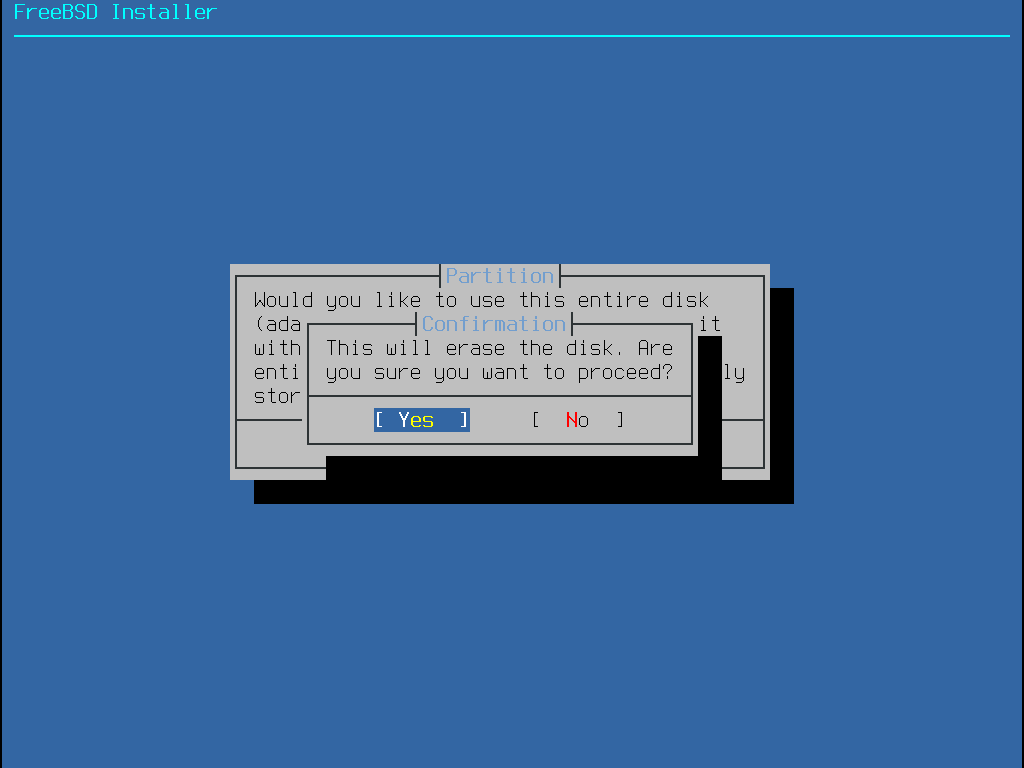
Figure xiii. Confirmation
The next menu shows a listing with the segmentation schemes types. GPT is usually the most advisable choice for amd64 computers. Older computers that are not uniform with GPT should use MBR. The other partition schemes are generally used for uncommon or older computers. More information is available in Partitioning Schemes.

Figure 14. Select Partition Scheme
Afterwards the partition layout has been created, review it to ensure it meets the needs of the installation. Selecting Revert will reset the partitions to their original values and pressing Auto will recreate the automated FreeBSD partitions. Partitions can likewise exist manually created, modified, or deleted. When the division is correct, select Finish to continue with the installation.

Figure 15. Review Created Partitions
Once the disks are configured, the next menu provides the concluding chance to make changes before the selected drives are formatted. If changes demand to be made, select Back to return to the chief partitioning menu. Revert & Exit exits the installer without making any changes to the drive. Select Commit to get-go the installation procedure.
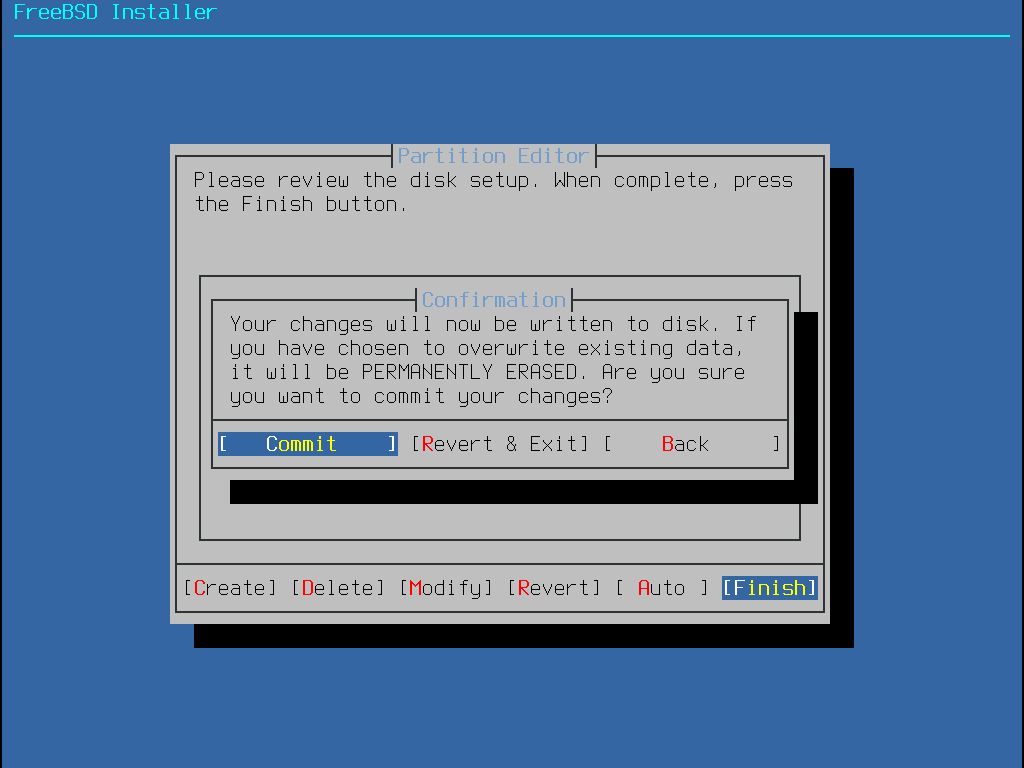
Figure 16. Final Confirmation
To continue with the installation process become to Fetching Distribution Files.
2.6.3. Transmission Partitioning
Selecting this method opens the sectionalisation editor:
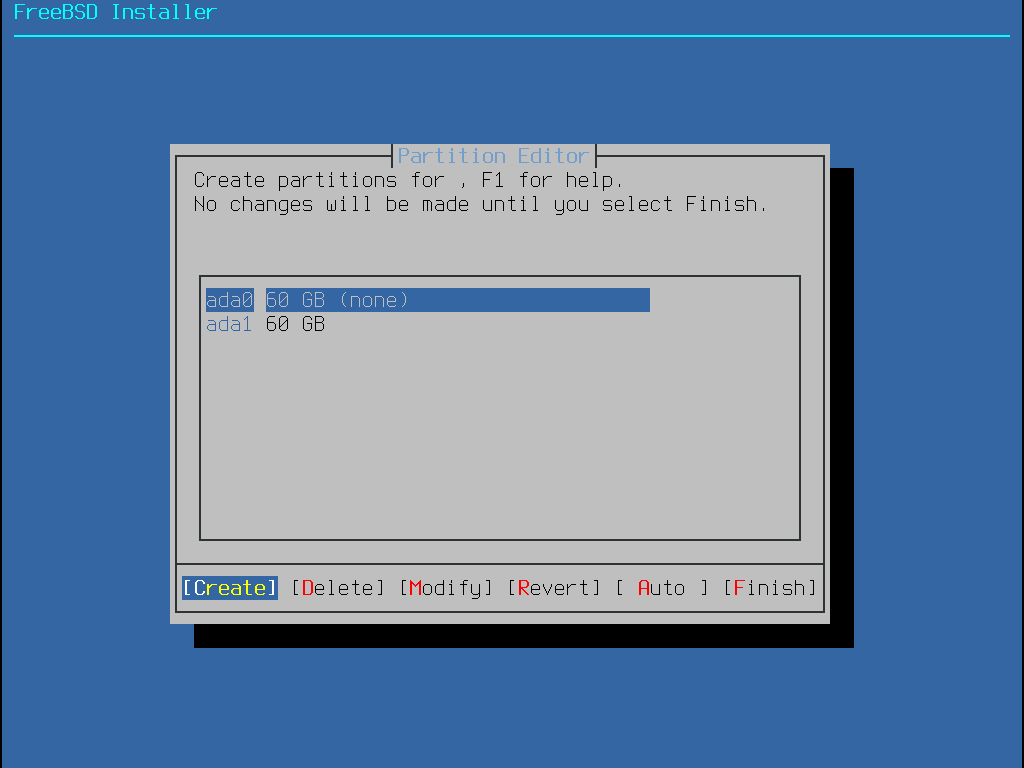
Figure 17. Manually Create Partitions
Highlight the installation drive (ada0 in this instance) and select Create to display a menu of bachelor sectionalization schemes:

Figure 18. Manually Create Partitions
GPT is usually the near advisable choice for amd64 computers. Older computers that are not compatible with GPT should utilize MBR. The other partition schemes are mostly used for uncommon or older computers.
| Abbreviation | Description |
|---|---|
| APM | Apple Division Map, used by PowerPC®. |
| BSD | BSD label without an MBR, sometimes chosen dangerously defended mode as not-BSD deejay utilities may not recognize it. |
| GPT | GUID Segmentation Table (http://en.wikipedia.org/wiki/GUID_Partition_Table). |
| MBR | Master Boot Tape (http://en.wikipedia.org/wiki/Master_boot_record). |
Afterwards the partitioning scheme has been selected and created, select Create again to create the partitions. The Tab key is used to motility the cursor between fields.

Effigy 19. Manually Create Partitions
A standard FreeBSD GPT installation uses at least three partitions:
-
freebsd-boot- Holds the FreeBSD boot code. -
freebsd-ufs- A FreeBSD UFS file system. -
freebsd-zfs- A FreeBSD ZFS file system. More information about ZFS is bachelor in The Z File Organisation (ZFS). -
freebsd-swap- FreeBSD swap infinite.
Refer to gpart(8) for descriptions of the available GPT partitioning types.
Multiple file system partitions can exist created and some people prefer a traditional layout with separate partitions for /, /var, /tmp, and /usr. See Creating Traditional Split File Organization Partitions for an example.
The Size may be entered with common abbreviations: K for kilobytes, Grand for megabytes, or One thousand for gigabytes.
| Proper sector alignment provides the best performance, and making sectionalization sizes even multiples of 4K bytes helps to ensure alignment on drives with either 512-byte or 4K-byte sectors. Mostly, using partition sizes that are even multiples of 1M or 1G is the easiest way to make certain every partition starts at an even multiple of 4K. In that location is i exception: the freebsd-kicking partition should be no larger than 512K due to current boot code limitations. |
A Mountpoint is needed if the partition volition contain a file system. If merely a single UFS partition will exist created, the mountpoint should be /.
The Label is a proper noun by which the division volition exist known. Drive names or numbers can change if the drive is continued to a dissimilar controller or port, simply the partition label does not change. Referring to labels instead of drive names and partition numbers in files like /etc/fstab makes the system more tolerant to hardware changes. GPT labels appear in /dev/gpt/ when a disk is fastened. Other partitioning schemes have different label capabilities and their labels announced in different directories in /dev/.
| Use a unique label on every partitioning to avoid conflicts from identical labels. A few letters from the computer's proper name, employ, or location can exist added to the label. For example, utilise |
Example 1. Creating Traditional Split File System Partitions
For a traditional partition layout where the /, /var, /tmp, and /usr directories are separate file systems on their own partitions, create a GPT division scheme, then create the partitions as shown. Sectionalization sizes shown are typical for a 20G target disk. If more space is available on the target disk, larger swap or /var partitions may exist useful. Labels shown here are prefixed with ex for "case", but readers should use other unique label values every bit described to a higher place.
By default, FreeBSD's gptboot expects the beginning UFS partition to be the / segmentation.
| Partition Type | Size | Mountpoint | Characterization |
|---|---|---|---|
| | | ||
| | | / | |
| | | | |
| | | /var | |
| | | /tmp | |
| | have the default (rest of the disk) | /usr | |
After the custom partitions take been created, select Stop to proceed with the installation and become to Fetching Distribution Files.
2.six.4. Guided Sectionalization Using Root-on-ZFS
This sectionalisation mode merely works with whole disks and volition erase the contents of the entire disk. The principal ZFS configuration carte offers a number of options to control the creation of the pool.
Here is a summary of the options which can exist used in this menu:
-
Install- Go on with the installation with the selected options. -
Puddle Blazon/Disks- Permit to configure thePool Blazonand the deejay(s) that volition institute the pool. The automated ZFS installer currently but supports the creation of a single top level vdev, except in stripe mode. To create more complex pools, use the instructions in Shell Manner Partitioning to create the pool. -
Rescan Devices- Repopulate the listing of available disks. -
Deejay Info- Deejay Info menu can be used to inspect each disk, including its partition table and various other information such as the device model number and series number, if available. -
Puddle Name- Institute the name of the pool. The default name is zroot. -
Force 4K Sectors?- Force the apply of 4K sectors. Past default, the installer will automatically create partitions aligned to 4K boundaries and strength ZFS to use 4K sectors. This is safe even with 512 byte sector disks, and has the added benefit of ensuring that pools created on 512 byte disks will exist able to have 4K sector disks added in the future, either as additional storage space or as replacements for failed disks. Press the Enter central to chose to activate it or non. -
Encrypt Disks?- Encrypting the disks allows the user to encrypt the disks using GELI. More data virtually disk encryption is available in "Disk Encryption with geli". Press the Enter key to chose activate it or not. -
Partition Scheme- Allow to choose the partition scheme. GPT is the recommended option in most cases. Press the Enter fundamental to chose between the unlike options. -
Bandy Size- Establish the amount of swap space. -
Mirror Swap?- Allows the user to mirror the swap between the disks. Be aware, enabling mirror swap will break crash dumps. Press the Enter fundamental to activate it or not. -
Encrypt Swap?- Allow the user the possibility to encrypt the swap. Encrypts the bandy with a temporary cardinal each time that the system boots and discards it on reboot. Press the Enter key to chose activate it or not. More information about swap encryption in "Encrypting Swap".
Select T to configure the Pool Blazon and the deejay(southward) that will constitute the pool.
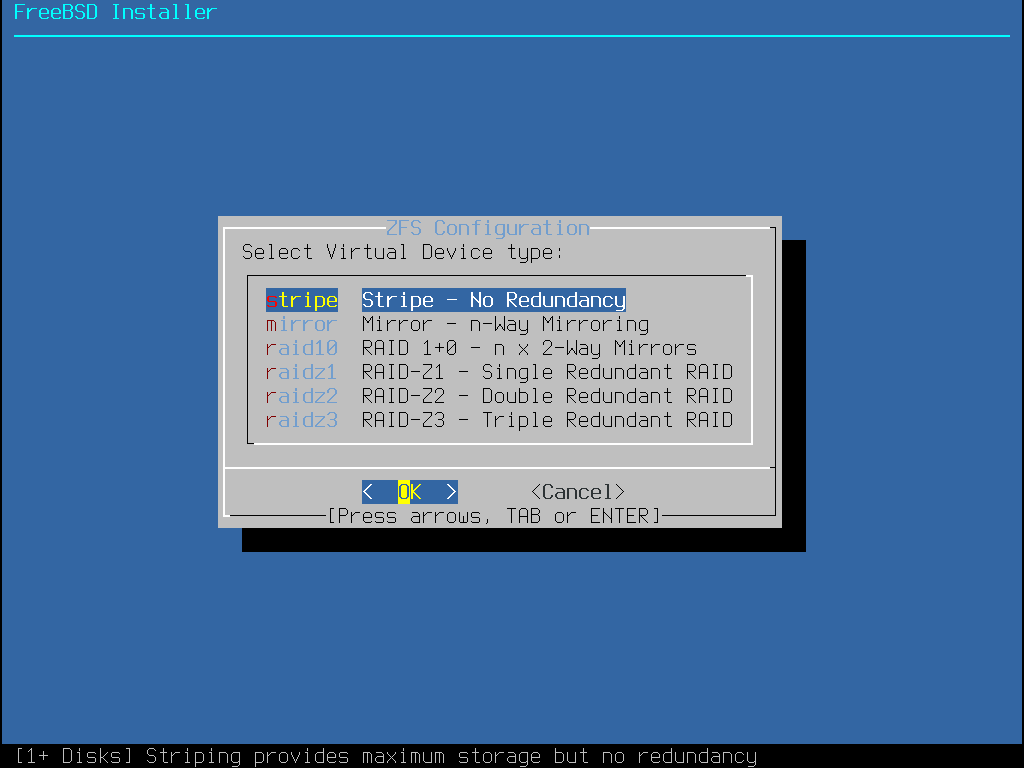
Figure 21. ZFS Pool Type
Here is a summary of the Pool Type which tin be selected in this menu:
-
stripe- Striping provides maximum storage of all connected devices, but no redundancy. If just 1 deejay fails the information on the pool is lost irrevocably. -
mirror- Mirroring stores a complete re-create of all data on every deejay. Mirroring provides a good read functioning because data is read from all disks in parallel. Write performance is slower as the information must be written to all disks in the pool. Allows all but one disk to neglect. This selection requires at least two disks. -
raid10- Striped mirrors. Provides the all-time performance, but the least storage. This choice needs at least an even number of disks and a minimum of four disks. -
raidz1- Single Redundant RAID. Let one disk to neglect meantime. This pick needs at least three disks. -
raidz2- Double Redundant RAID. Allows ii disks to fail concurrently. This option needs at least four disks. -
raidz3- Triple Redundant RAID. Allows iii disks to fail meantime. This option needs at least five disks.
Once a Pool Type has been selected, a list of available disks is displayed, and the user is prompted to select ane or more disks to make upwardly the puddle. The configuration is then validated, to ensure enough disks are selected. If not, select <Change Option> to return to the list of disks, or <Dorsum> to change the Puddle Type.

Effigy 22. Disk Option

Figure 23. Invalid Selection
If one or more disks are missing from the list, or if disks were attached after the installer was started, select - Rescan Devices to repopulate the list of available disks.
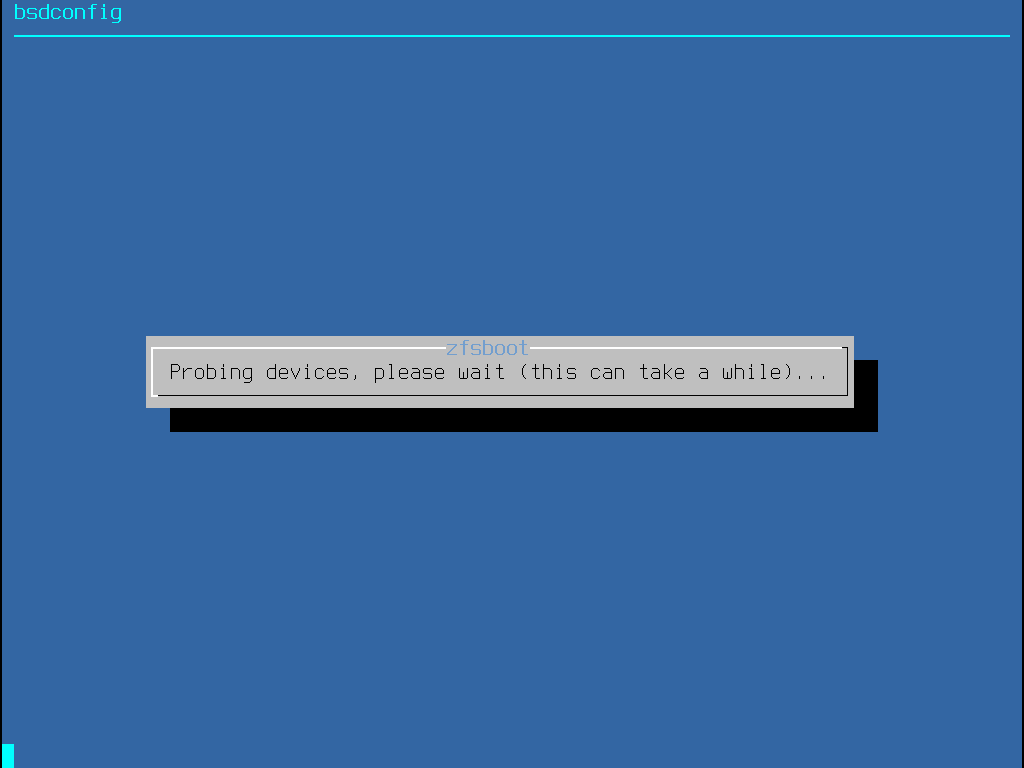
Figure 24. Rescan Devices
To avoid accidentally erasing the incorrect deejay, the - Disk Info menu can exist used to audit each deejay, including its partition table and various other data such as the device model number and serial number, if available.
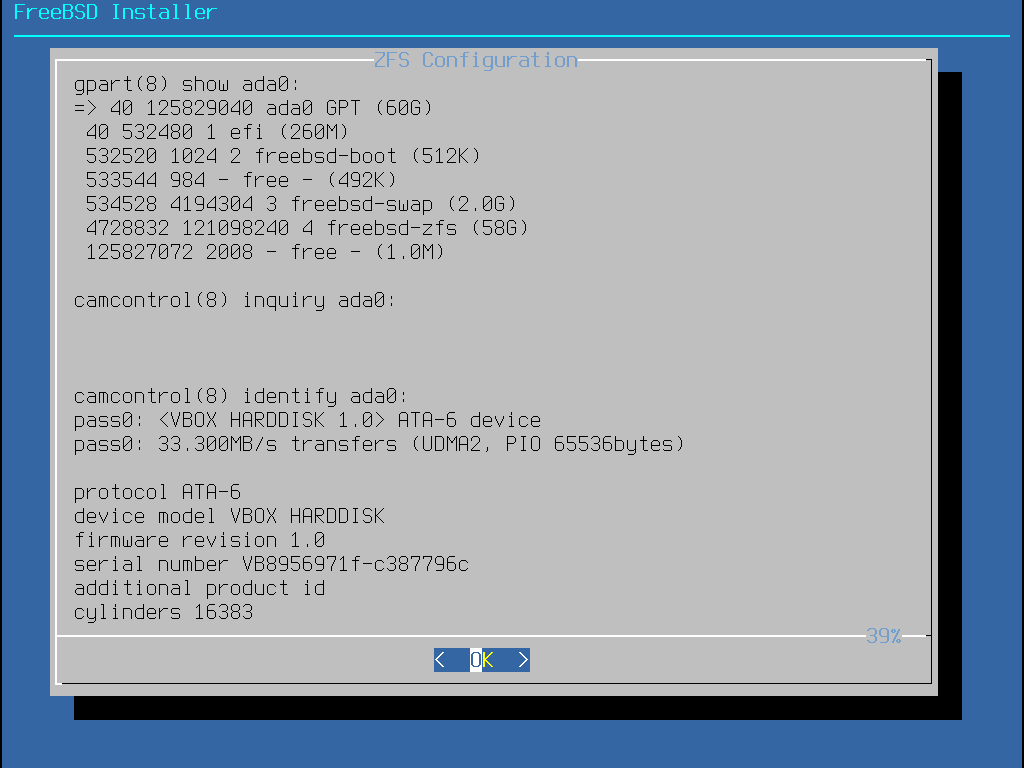
Figure 25. Analyzing a Disk
Select N to configure the Puddle Proper name. Enter the desired name then select <OK> to constitute it or <Cancel> to return to the main menu and leave the default proper noun.
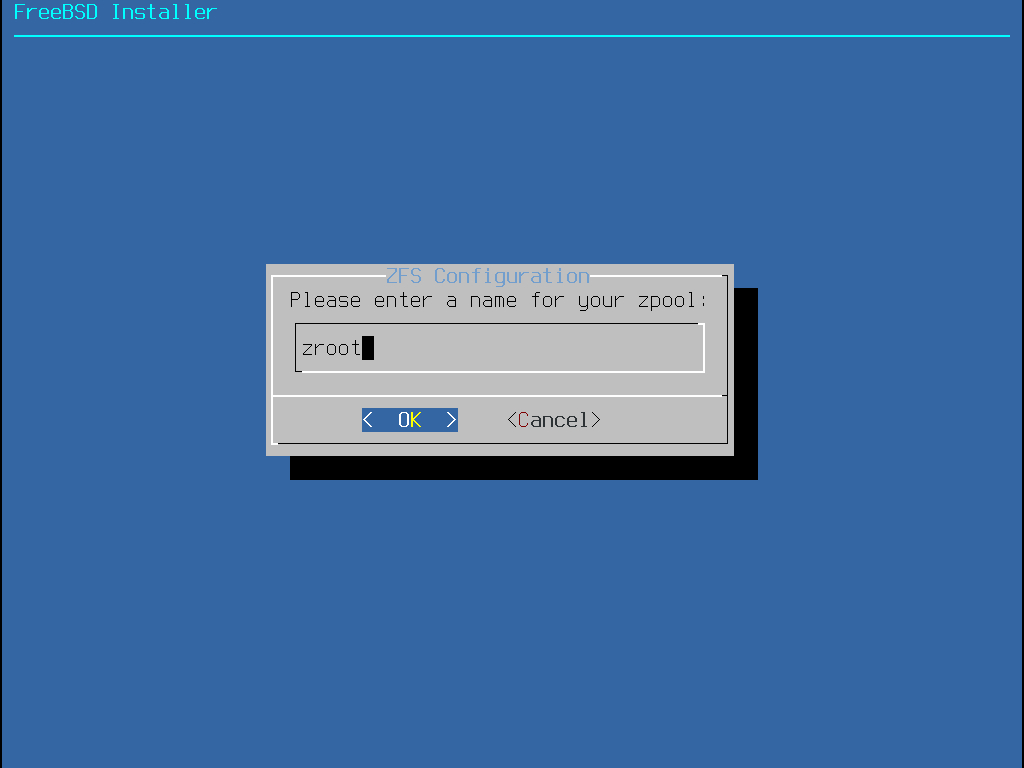
Figure 26. Pool Name
Select Southward to gear up the amount of swap. Enter the desired amount of swap and then select <OK> to establish it or <Cancel> to render to the principal card and let the default amount.
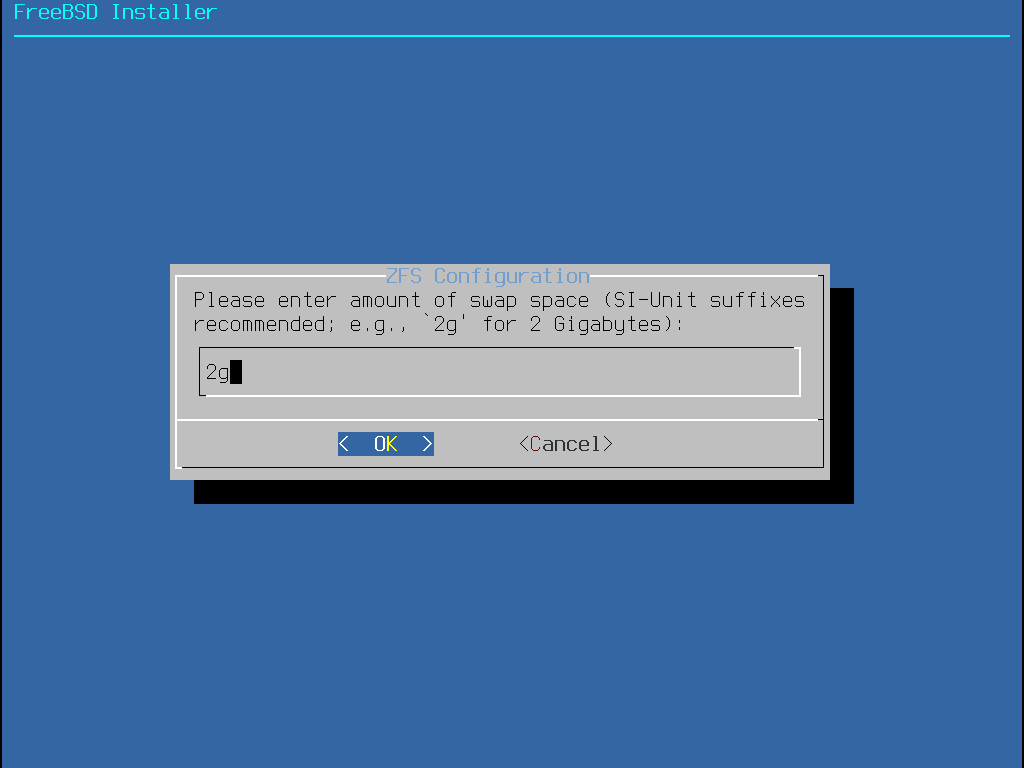
Figure 27. Swap Corporeality
Once all options have been set to the desired values, select the >>> Install option at the height of the carte. The installer so offers a last gamble to cancel before the contents of the selected drives are destroyed to create the ZFS pool.

Figure 28. Last Chance
If GELI disk encryption was enabled, the installer will prompt twice for the passphrase to be used to encrypt the disks. And after that the initializing of the encryption begins.
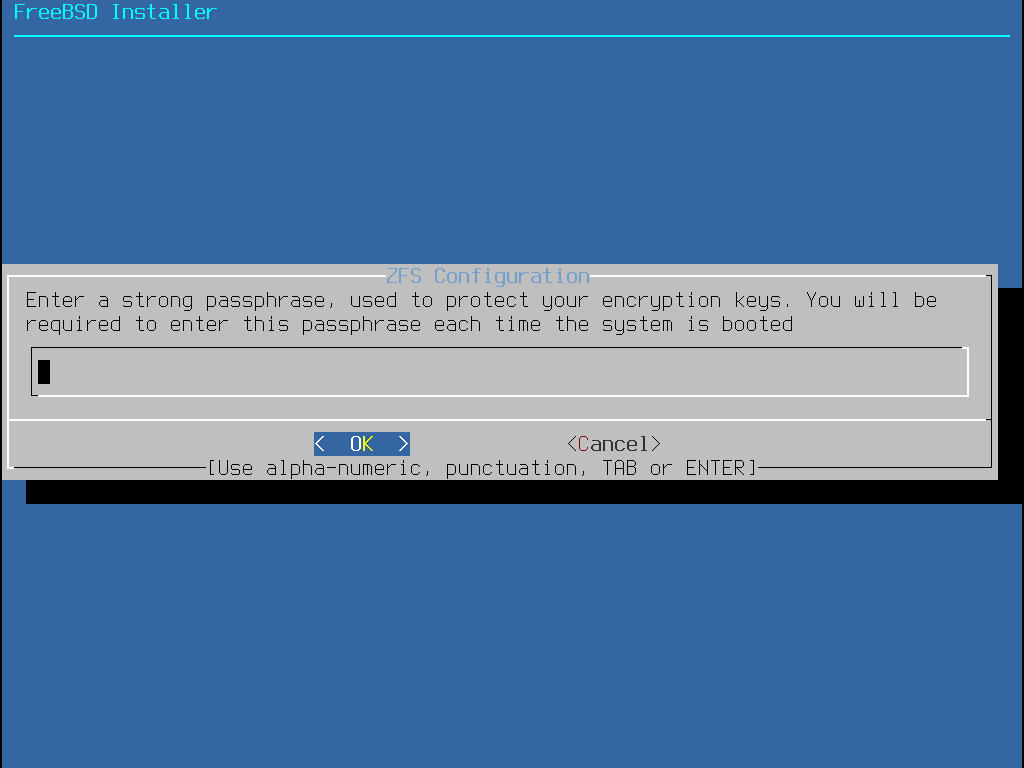
Figure 29. Disk Encryption Password

Figure 30. Initializing Encryption
The installation so proceeds usually. To proceed with the installation become to Fetching Distribution Files.
two.6.v. Beat Mode Partitioning
When creating advanced installations, the bsdinstall partitioning menus may not provide the level of flexibility required. Advanced users can select the Shell option from the segmentation menu in order to manually partition the drives, create the file system(s), populate /tmp/bsdinstall_etc/fstab, and mountain the file systems nether /mnt. Once this is washed, type go out to return to bsdinstall and continue the installation.
How To Repair Zpool Permissions,
Source: https://docs.freebsd.org/en/books/handbook/bsdinstall/
Posted by: perryvily1979.blogspot.com


0 Response to "How To Repair Zpool Permissions"
Post a Comment